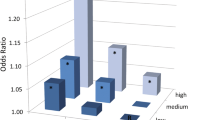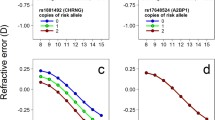Abstract
To examine the familial correlations, heritability (h 2) and common environmental components (c 2) of myopia and ocular biometric traits (all treated as continuous outcomes) in families collected through the Genes in Myopia (GEM) family study in Australia. A total of 132 pedigrees (723 participants) were recruited for this study. All individuals completed a risk factor questionnaire and underwent a detailed eye examination including spherical equivalent (SphE) and ocular biometric measurements of axial length (AL), anterior chamber depth (ACD) and corneal curvature (CC). Familial correlations were calculated and h 2 and c2 were estimated using a variance component model that assumes a multivariate t distribution within each pedigree. Two definitions of common environments (c 2) were considered: nuclear family (current) shared environment (Model 1) and sib-ship (childhood) shared environment (Model 2). Population ascertainment adjustment was performed using the Blue Mountains eye study dataset. The trends observed for familial correlations suggested that SphE is influenced by both environmental and genetic factors whereas AL, ACD and CC are predominantly genetically determined. This was largely confirmed by variance components modelling. Heritability estimates (adjusted for age, sex and years of education) from the best fitting ACE model (Model 2, childhood shared environment) were 0.50 ± 0.05 for SphE, 0.73 ± 0.04 for AL, 0.78 ± 0.04 for ACD and 0.16 ± 0.06 for CC. Childhood environmental effects were significant with c 2 estimated to be 0.33 ± 0.04 for SphE, 0.06 ± 0.03 for AL, 0.22 ± 0.04 for ACD and 0.10 ± 0.05 for CC. Age was associated with SphE, total years of education was associated with AL and sex was associated with all traits studied. We used a novel and conservative approach to account for and estimate common environmental effects by specifying either nuclear family or sib-ship environment when estimating heritability estimates and showed that all traits examined (SphE, AL, ACD and CC) are heritable, thus reflecting a genetic component. These traits therefore all represent candidates for quantitative trait linkage analyses.

Similar content being viewed by others
References
Adams DW, McBrien NA (1992) Prevalence of myopia and myopia progression in a population of clinical microscopist. Optom Vis Sci 69:467–473
Akaike H (1974) New look at statistical-model identification. IEEE T Automat Contr AC19:716–723
Almasy L, Blangero J (1998) Multipoint quantitative-trait linkage analysis in general pedigrees. Am J Hum Genet 62:1198–1211
Alsbirk PH (1975) Anterior-chamber of eye—genetic and anthropological study in Greenland Eskimos. Hum Hered 25:418–427
Alsbirk PH (1977) Variation and heritability of ocular dimensions—population study among adult Greenland Eskimos. Acta Ophthalmol 55:443–456
Alsbirk PH (1979) Refraction in adult west Greenland Eskimos—population study of spherical refractive errors, including oculometric and familial correlations. Acta Ophthalmol 57:84–95
Biino G, Palmas MA, Corona C, Prodi D, Fanciulli M, Sulis R, Serra A, Fossarello M, Pirastu M (2005) Ocular refraction: heritability and genome-wide search for eye morphometry traits in an isolated Sardinian population. Hum Genet 116:152–159
Blackie CA, Harris WF (1997) Refraction and keratometry: departures from and transformations toward multivariate normality. Optom Vis Sci 74:452–458
Charlesworth JC, Dyer TD, Stankovich JM, Blangero J, Mackey DA, Craig JE, Green CM, Foote SJ, Baird PN, Sale MM (2005) Linkage to 10q22 for maximum intraocular pressure and 1p32 for maximum cup-to-disc ratio in an extended primary open-angle glaucoma pedigree. Invest Ophthalmol Vis Sci 46:3723–3729
Curtin B (1985) The Myopias. Basic science and clinical management. Harper and Row, Philadelphia
Curtin BJ, Karlin DB (1971) Axial length measurements and fundus changes of myopic eye. Am J Ophthalmol 1(1 Part 1):42–53
Dirani M, Chamberlain M, Shekar SN, Islam AFM, Garoufalis P, Chen CY, Guymer RH, Baird PN (2006) Heritability of refractive error and ocular biometrics: the genes in myopia (GEM) twin study. Invest Ophthalmol Vis Sci 47:4756–4761
Ferris FL, Kassoff A, Bresnick GH, Bailey I (1982) New visual-acuity charts for clinical research. Am J Ophthalmol 94:91–96
Foran S, Rose K, Wang JJ, Mitchell P (2002) Correctable visual impairment in an older population: the blue mountains eye study. Am J Ophthalmol 134:712–719
Garoufalis P, Chen C, Dirani M, Couper T, Taylor H, Baird P (2005) Methodology and recruitment of probands and their families for the genes in myopia (GEM) study. Ophthalmic Epidemiol 12:1–10
Hammond CJ, Andrew T, Mak YT, Spector TD (2004) A susceptibility locus for myopia in the normal population is linked to the PAX6 gene region on chromosome 11: a genomewide scan of dizygotic twins. Am J Hum Genet 75:294–304
Hammond CJ, Snieder H, Gilbert CE, Spector TD (2001) Genes and environment in refractive error: the twin eye study. Invest Ophthalmol Vis Sci 42:1232–1236
Hopper J (2000) Why ‘common environmental effects’ are so uncommon in the literature. In: Spector T, Snieder H, MacGregor A (eds) Advances in twin and sib-pair analysis. Oxford University Press, London, pp 151–165
Hopper J, Matthews J (1982) Extensions to multivariate normal models for pedigree analysis. Am J Hum Genet 46:373–383
Ip J, Son C, Kifley A, Mitchell P, Robaei D, Rose K, Morgan I, Smith W (2006) Impact of parental myopia and nearwork on childhood refraction: a comparison of two ethnic groups in the Sydney myopia study. Ophthal Physiol Opt 26(Suppl 1):30
Javitt J, Chiang Y (1994) The socioeconomic aspects of laser refractive surgery. Arch Ophthalmol 112:1526–1530
Kempen J, Mitchell P, Lee K, Tielsch J (2004) The prevalence of refractive error among adults in the United States, Western Europe, and Australia. Arch Ophthalmol 122:495–505
Lange K (2002) Mathematical and statistical methods for genetic analysis. Springer, Berlin Heidelberg New York
Lange K, Boehnke M (1983) Extensions to pedigree analysis. IV Covariance components models for multivariate traits. Am J Med Genet 14:513–514
Lyhne N, Sjolie AK, Kyvik KO, Green A (2001) The importance of genes and environment for ocular refraction and its determiners: a population based study among 20–45 year old twins. Br J Ophthalmol 85:1470–1476
Naiglin L, Gazagne C, Dallongeville F, Thalamas C, Idder A, Rascol O, Malecaze F, Calvas P (2002) A genome wide scan for familial high myopia suggests a novel locus on chromosome 7q36. J Med Genet 39:118–124
Paluru P, Ronan SM, Heon E, Devoto M, Wildenberg SC, Scavello G, Holleschau A, Makitie O, Cole WG, King RA, Young TL (2003) New locus for autosomal dominant high myopia maps to the long arm of chromosome 17. Invest Ophthalmol Vis Sci 44:1830–1836
Paluru PC, Nallasamy S, Devoto M, Rappaport EF, Young TL (2005) Identification of a novel locus on 2q for autosomal dominant high-grade myopia. Invest Ophthalmol Vis Sci 46:2300–2307
Pararajasegaram R (1999) VISION 2020-the right to sight: from strategies to action. Am J Ophthalmol 128:359–360
Rabsilber TM, Becker KA, Frisch IB, Auffarth GU (2003) Anterior chamber depth in relation to refractive status measured with the orbscan II topography system. J Cataract Refr Surg 29:2115–2121
Saw S-M, Tan S-B, Fung D, Chia K-S, Koh D, Tan DTH, Stone RA (2004) IQ and the association with myopia in children. Invest Ophthalmol Vis Sci 45:2943–2948
Saw SM (2003) A synopsis of the prevalence rates and environmental risk factors for myopia. Clin Exp Optom 86:289–294
Saw SM, Chua WH, Gazzard G, Koh D, Tan DTH, Stone RA (2005) Eye growth changes in myopic children in Singapore. Brit J Ophthalmol 89:1489–1494
Saw SM, Wu HM, Seet B, Wong TY, Yap E, Chia KS, Stone RA, Lee L (2001) Academic achievement, close up work parameters, and myopia in Singapore military conscripts. Br J Ophthalmol 85:855–860
Schwartz M, Haim M, Skarsholm D (1990) X-linked myopia: Bornholm eye disease. Linkage to DNA markers on the distal part of Xq. Clin Genet 38:281–286
Stambolian D, Ibay G, Reider L, Dana D, Moy C, Schlifka M, Holmes T, Ciner E, Bailey-Wilson JE (2004) Genomewide linkage scan for myopia susceptibility loci among Ashkenazi Jewish families shows evidence of linkage on chromosome 22q12. Am J Hum Genet 75:448–459
Taylor H, West S (1988) A simple system of clinical grading of lens opacities. Lens Res 5:175–181
Teikari JM, O’Donnell JJ, Kaprio J, Koskenvuo M (1989) Genetics and environmental effects on oculometric traits. Optom Vis Sci 66:594–599
Teikari JM, Odonnell J, Kaprio J, Koskenvuo M (1991) Impact of heredity in myopia. Hum Hered 41:151–156
Wojciechowski R, Congdon N, Bowie H, Munoz B, Gilbert D, West SK (2005) Heritability of refractive error and familial aggregation of myopia in an elderly American population. Invest Ophthalmol Vis Sci 46:1588–1592
Wong TY, Foster PJ, Johnson GJ, Seah SKL (2002) Education, socioeconomic status, and ocular dimensions in Chinese adults: the Tanjong Pagar survey. Br J Ophthalmol 86:963–968
Young TL, Ronan SM, Alvear AB, Wildenberg SC, Oetting WS, Atwood LD, Wilkin DJ, King RA (1998a) A second locus for familial high myopia maps to chromosome 12q. Am J Hum Genet 63:1419–1424
Young TL, Ronan SM, Drahozal LA, Wildenberg SC, Alvear AB, Oetting WS, Atwood LD, Wilkin DJ, King RA (1998b) Evidence that a locus for familial high myopia maps to chromosome 18p. Am J Hum Genet 63:109–119
Zhang Q, Guo X, Xiao X, Jia X, Li S, Hejtmancik JF (2005) A new locus for autosomal dominant high myopia maps to 4q22-q27 between D4S1578 and D4S1612. Mol Vis 11:554–560
Acknowledgment
The authors would like to extend special thanks to the GEM family study and BMES subjects who made this study possible, and to Professor John Hopper and Dr Mark Jenkins for their advice on statistical methods. This research was supported by the Australian Federal Government through the Cooperative Research Centres Program, Ernest and Grace Matthaei Trust, National Health and Medical Research Council (Grant #400255), Joan and Peter Clemenger Trust, Helen Macpherson Smith Trust, L.E.W Carty Trust, Angior Family Foundation, Stoicescu Trust, William Buckland Foundation, the Sunshine Foundation and Eye Research Australia Foundation. The helpful comments of two anonymous reviewers are also acknowledged.
Author information
Authors and Affiliations
Corresponding author
Rights and permissions
About this article
Cite this article
Chen, C.YC., Scurrah, K.J., Stankovich, J. et al. Heritability and shared environment estimates for myopia and associated ocular biometric traits: the Genes in Myopia (GEM) family study. Hum Genet 121, 511–520 (2007). https://doi.org/10.1007/s00439-006-0312-0
Received:
Accepted:
Published:
Issue Date:
DOI: https://doi.org/10.1007/s00439-006-0312-0




